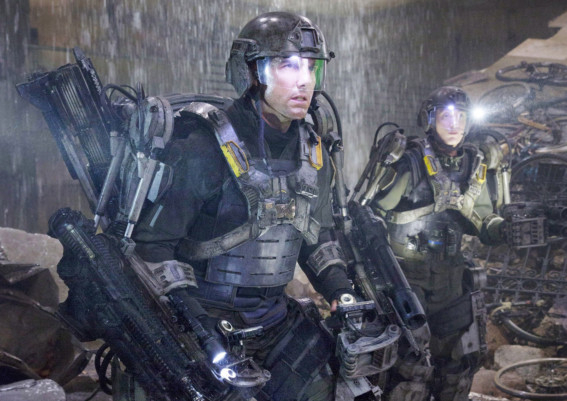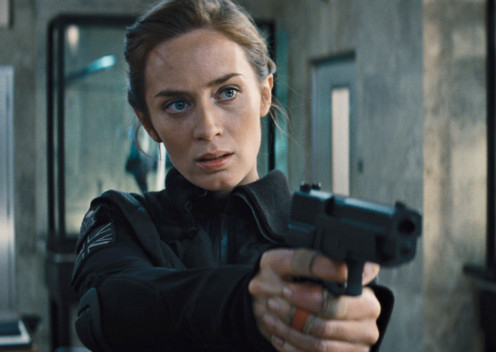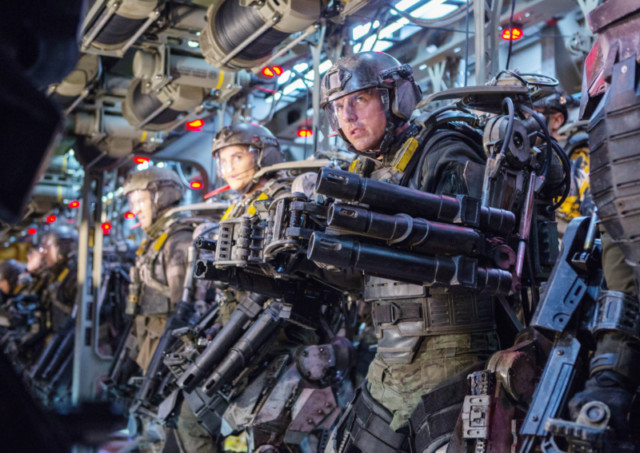
Anyone who watches a lot of blockbuster cinema soon hardens to the familiarity of most product, to the relentless recycling of the same handful of once-decent ideas. So the new Spider-Man series looks like the old Spider-Man series; the new Godzilla reboot is better than the old Godzilla reboot, but came too soon after Pacific Rim, which was just Godzilla with robots. You find yourself getting weary and jaded, and asking as showbiz agents do with a yawn in the old movies so, what else ya got?
Well, here’s an interesting something else. The new Tom Cruise showcase, Edge of Tomorrow, represents an ingenious admission that, while there’s nothing new under the sun of genre cinema, recycling can still be creative and that, if you’re going to do it, you might as well do it blatantly.
At first sight, Edge of Tomorrow is only too routine. Humans going to war in robotic exoskeletons? Seen it as long ago as Aliens and countless times since. A man stuck in a time loop, fated to relive the same action endlessly? Seen it in Groundhog Day.
As for the formula Aliens meets Groundhog Day that’s surely flogging two dead horses at once. But because Edge of Tomorrow is effectively about the infinite refloggability of cinematic horses, it manages to break the chain of formulaic repetition and come out surprisingly fresh.
The film is reliant on well-placed surprises, so here I’ll plant a neon-lit SPOILER ALERT! and let you take your chances. So: in the near future, Earth faces an extraterrestrial invasion force of wildly flailing metallic octopus things.
American officer William Cage (Tom Cruise) finds himself reduced to the ranks and dispatched to the front line; he’s actually an adman in charge of military PR, so when he’s sent into battle under Bill Paxton’s beaming headbanger sergeant, he’s hopelessly out of his depth. The initial combat scenes, with hardware crashing from the skies and Cage palpably terrified, are intense, chaotic stuff: here’s a rare sci-fi battle epic that tells you from the off that war isn’t actually much fun.
The twist: Cage is killed in battle but, because of a mysterious time loop, finds himself repeatedly sent back to the field to relive the same moments. He keeps getting killed over again, but learns some survival tricks along the way, thanks to super-soldier Rita Vrataski (Emily Blunt), the poster girl for the war effort. The trick each time is to get further in the battle before returning to your starting point. In Beckettian terms, “Fail again. Fail better.” More mundanely, it’s just like a video game.
It’s a good 20 years since people noticed that Hollywood action movies were following the lead of Nintendo in both look and structure. Edge of Tomorrow refreshes that familiar notion and takes it a little further, a little more consistently, and a lot more self-consciously than most films.
James Herbert’s editing throws us in and out of the action, forever bringing us back to zero with a jerk but with rhythmic variations, so that we don’t hit the same points of the loop every time. Director Doug Liman (The Bourne Identity, Mr and Mrs Smith) is astute at judging when the conceit is wearing thin, and when to open up surprising new pockets of action in the timeline.
Edge of Tomorrow is also different in casting Cruise not as his usual hyper-athletic grinner, but as a hapless and initially unlikeable dork. His Cage only starts to become competent, and redeemable, thanks to rigorous instruction from Blunt’s Vrataski, the film’s real warrior icon. Feminist sci-fi? Only up to a point: by the end, Cage has at least levelled with Vrataski in the hard nut stakes, but while he’s flapping about cluelessly, it’s a lot of fun to see Cruise looking halfway human for a change.
Based on Hiroshi Sakurazaka’s novel All You Need Is Kill, the film is a little more prestigious than your routine blockbuster. The intricate, knowing script is credited to Christopher McQuarrie (The Usual Suspects) and to esteemed British playwright Jez Butterworth and his brother John-Henry Butterworth. Add cinematographer Dion Beebe, a collaborator of Michael Mann and Jane Campion, and leading effects whizz Nick Davis, and there’s some distinctive clout here.
While hardly a game-changer, Edge of Tomorrow reworks its old tropes with wit and brio. Given the weary complacency with which most commercial cinema settles for its own second-handedness, it’s a pleasure to see a film so utterly brazen about its own derivative nature. It almost makes you want to see if they can pull off a sequel Edge of Tomorrow 2: Seen It All Before.
Edge of Tomorrow is out in the UAE on June 5,









